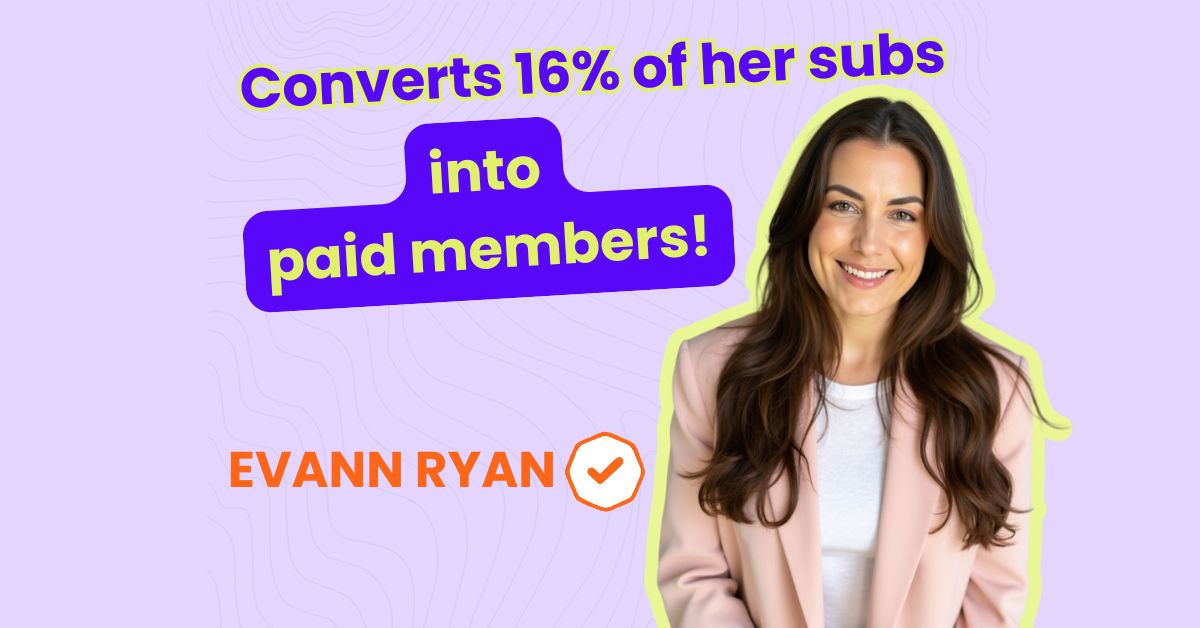Interview Date: March 10, 2024
Table of Content
CREATOR INTERVIEW
Bill Kerr is an ambitious newsletter creator who is chasing Lenny Rachitsky.
As a CEO himself, he wants his newsletter Open Source CEO, to be the ultimate destination for founders, investors and leaders to be entertained and educated.
In line with this vision, he has already reached over 25,000 subscribers & $6,000 in monthly revenue in one year. His objective for 2024 is to hit 150,000 subscribers!
As a creator who adopted a build-in-public approach, Bill Kerr shared immensely valuable insights in our interview today, including:
- How Open Source CEO complements his work as a startup CEO
- Key learnings about paid growth and paid recommendation platforms in comparison
- Lead magnet strategy he uses
- Results from 3 newsletter acquisitions
- How he maximizes his sponsorship revenue
- The well-working system he builds with a content assistant for a smooth delegation and to focus what really matters
Let’s dive in!
NEWSLETTER IDENTITY CARD
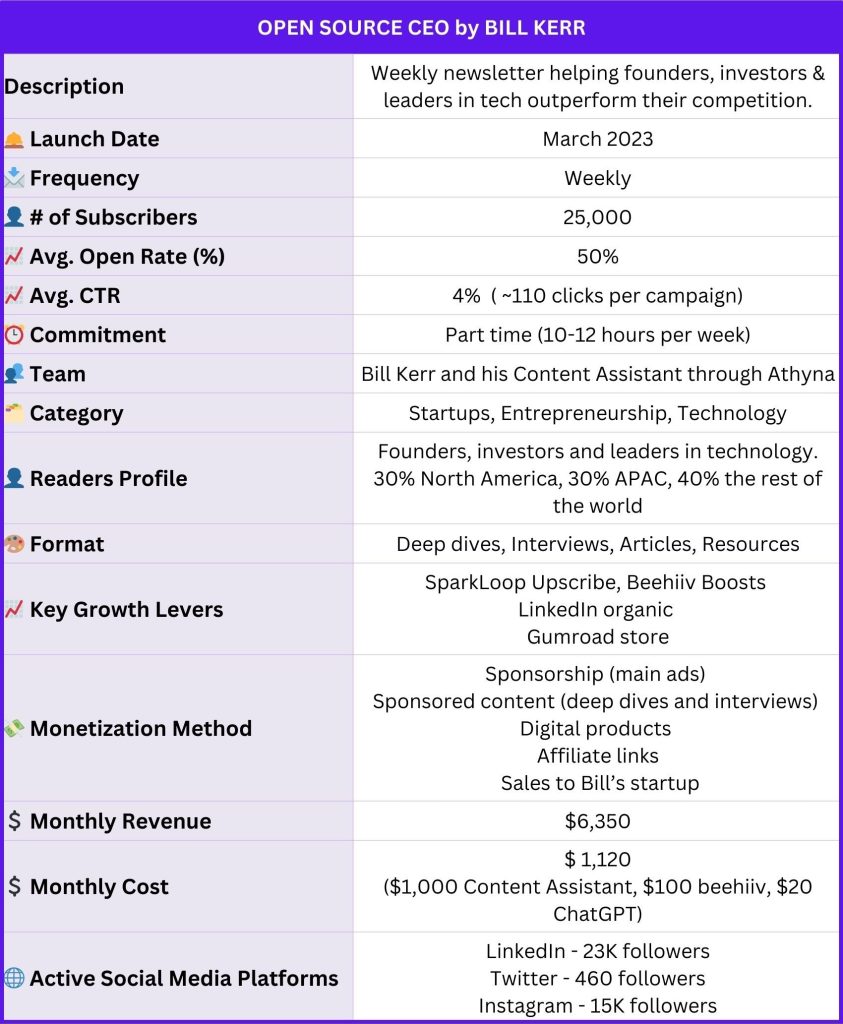
TOOL STACK
- ESP → Beehiiv*
- Writing → Notion
- Research → ChatGPT
- Planning & Task management → Notion
- Curation & Note-taking → Notion
- Design of visuals → Canva
- Digital products → Notion & GumRoad
- Growth → Sparkloop* & Beehiiv Boosts*
- Social Media → Taplio
- Affiliates → PartnerStack
- Sponsorship → Passionfroot
- Team → Athyna
- Payment → Stripe
- Incorporation → Stripe Atlas
MEET THE CREATOR
Welcome Bill. Let’s start with getting to know you.
I have a funny career, as it’s been very non-typical so far.
I have never worked inside of a startup, nor worked in corporate. I was a tradie for a decade and bought and sold real estate from a really young age. I purchased my first house at 19, second at 21 and third by 22. I was the most successful 22 year old you could ever imagine.
“At 23 though, I had a health scare and it totally shifted my priorities. I went from obsessing about real estate, my net worth, financial success, to none of that.
I threw it out the window and decided life was short and I wanted to travel the world.
I took off as soon as I was well and spent the next half a decade with a backpack on my back travelling to 40-50 countries along the way.
During this time, I swam with sharks, patted lions, and visited the world’s three biggest waterfalls. I explored jungles, forests, deserts, and more.
It was an awesome experience and really shaped who I am today.”
After coming back home at 26 or so, I spent a brief stint in the fitness industry and then at 28 I founded my first startup, AdventureFit. AdventureFit was a beautiful idea but a horrible business. The tagline was ‘improving the world through travel, exercise, mindfulness and conversation’.
What we actually did was, we took people all around the world on adventure holidays for the wellness community. Picture this – Vietnam with cave exploring, rock-climbing, yoga, meditation, training etc..
We went to Mexico, South Africa, Iceland, you name it. The product was incredible, and the experience was second to none, but we never really made any money. I probably hung on two years longer than I should have, and after about four years, we would it up.
All of this led me to Athyna, which is the startup I founded and run full-time today. We build remote teams.
“So I’ve gone up and down and around in circles to get where I am today.
Now, I am a happy founder & CEO, I invest and mentor at Startmate back in Australia and I write my newsletter Open Source CEO.
Open Source CEO came out of nowhere really. I didn’t expect to be here but I am loving it and so is the audience, so … so far so good.”
START
How and why did you decide to start Open Source CEO newsletter? Did you have a clear objective from the beginning, or has it evolved over time?
I started Open Source CEO after hearing about the success of The Hustle and The Milk Road on the My First Million podcast. I have always been a creative, and enjoyed writing in school but I’d never really done much of it in my professional life.
Having said that, even when we had really good copywriters on our team at Athyna, all the highest-value copywriting duties, like the copy on our site, would get given to me.
“After hearing about the business model of newsletters and seeing the rise in the creator economy, I started thinking about how I might be able to build a newsletter that could complement my day-to-day work at Athyna. “
As a CEO, I think of my job description as setting the strategy, having enough finances to execute said strategy, hiring an All-Star team, communicating, and holding people accountable.
If you think about Open Source CEO it aligns incredibly well with my job description.
Strategy-wise, I am always learning from founders (interviews) and studying successful business cases (deep dives). Then, when it comes to raising money, building my brand, and especially now, having a budding ‘community’ opens doors with investors.
This leads to the next point: hiring the All-Star team. This has always been relatively easy at Athyna because we have 91% engagement (culture) scores and a great employer brand, but now, thanks to my newsletter, it is even easier again.
Communication-wise, it is an easy fit as well. I get to a) build an engaged, trusting audience and b) talk about Athyna. I plug Athyna in some relatively organic-ish way every edition. And I do build-in public posts. My personal pipeline has exploded since launching the newsletter.
The only thing my newsletter doesn’t really influence is the point about holding people accountable. So overall, it’s a great fit. But to answer your question, I’ve never really had a clear objective. I just want it to be fun and entertaining.
“My loose goal is to be known as the ‘Lenny of leadership’ and I feel like I am well on my way to getting there.”
GROWTH
Which strategies did you use to grow over 25,000 subscribers?
Growth has been a funny one. I have done a little bit of everything.
I started by building a pre-launch hype list of around 500 people—not that many, but still decent. This was really my LinkedIn audience, as that’s the main place I have a following.
After that, I moved straight to paid.
I have run ads in beehiiv Boosts, SparkLoop, Refind Ads, Twitter, Meta etc etc.. I found the most success with SparkLoop* and beehiiv Boosts*. At one point, I could get a lead at Refind for 0.70c, but the opens were at 38% or so, so although they were cheap. You get what you pay for.
Today, I spend almost all of my marketing budget at SparkLoop, where I have a 70% open and 3% click on paid subs. Pretty bonkers really.
I have run many paid ads in the past, so I know I could probably beat these results on Twitter and Meta, but it would also be a lot heavier lifting.
“Boosts are good, around 50% and better clicks but SparkLoop* wins in my eyes. Plus the liquidity in the network is higher meaning I can grow faster and more consistently there if I like.”
One of the things that I need to focus on is making sure that the main thing stays the main thing—my startup, Athyna.
Elaboration on newsletter acquisitions
Another thing I have done over the last 12 months is buy three other newsletters.
I did this as somewhat of a trial, as I think there are too many newsletters out there right now and a lot of them will come on the market in the short to medium term.
“Successful newsletter acquisitions–Morning Brew, Milk Road and other recent large sales–sell at a subscriber to dollar price of ~$43 per subscriber.
And you can buy a dying newsletter for $0.50c per sub today.
That’s a huge arbitrage.”
Obviously, I am comparing myself with the top end of the market but that’s where I expect Open Source CEO to sit when it’s all said and done.
So, I have purchased a small AI newsletter, a small startup newsletter and small Notion tools newsletter.
“Every acquisition had decent open and click rates of around 43% and 2-3%, all of which were higher than the original newsletters, with no real difference in unsubscribed.“
I will not do any more acquisitions now until I feel like there is a really great content overlap, but at least I know the strategy can work.
Elaboration on lead magnets strategy
Another thing that has worked well so far is lead magnets.
I call them lead magnets but that’s not really how I think of them. I am a founder and a CEO and I know business is really hard, so I wanted to try to make it a little bit easier for founders and leaders out there by sharing all the best tools & resources we have for others to plug into their operations.
It’s all built in Notion and we have a lot of great tools. Investor CRM, OKRs Template, Swipe File, Content Planner and more.
At Athyna, and in my day-to-day, we swear by Notion, and we would be considered power users, so the tools are actually very high quality. Much more so than most of the stuff you will download from your typical Gumroad store.
“These tools have been downloaded thousands of times so far.
Yes, this is lead gen, but I think of it more in terms of building a deeper connection with my readers and a much higher level of trust with them.”
At the moment, we are betting on reciprocity here, but in the next months, we will start to roll out paid tools, email-based courses, and more. So, the fact that we have built trust with our audience will work great because if they do decide to use a paid tool, they’ll know it will be of value.
Regarding growth efforts, what would you do differently if you had a chance to start over?
I wouldn’t change too much, as in order to get where I am today, I needed to test and learn, and fail a little bit too. Having said that, I won’t be going back to low-quality Refind Ads too much again in the future, and when I have time, I will definitely try to move over to Twitter and Meta Ads.
I don’t love how with SparkLoop and Boosts you need to dilute the subscriber experience and also add more competition for eyeballs into your new subscribers ’s inbox.
“So overall, I’d focus on higher quality subs and less dilutive channels.”
You have an ambitious goal of reaching 150K subscribers this year. What is your strategy to achieve this?
I plan to start outbound with sponsorship in the next few weeks, with a plan to sell 2-3x the inventory. I have been super lucky so far that I have a 100% fill rate and all with sponsors of which I use their product.
I also am about to launch a paid version of the newsletter.
With more revenue, it will mean more growth.
I am lucky that I am able to put 100% of my revenue back into growth as I have my CEO salary. I don’t get paid that much but enough for the newsletter to just continue to fuel the newsletter.
I am in the mix to purchase a 20k newsletter right now with an all (or near all) vendor financing deal. Meaning, I will buy it for no money down. So that will help.
“If I am honest, I am aiming for 150k but also no surefire way to get there.
But I am smart, driven, hungry and ambitious … and my content is good. So, I’m in with half a chance.”
MONETIZATION
Let’s talk about your sponsorship strategy.
How do you find sponsors? Do you have a process & system in place?
I have only really had inbound so far. Athyna (via our Head of Growth), The Startup Podcast, Sidebar and Deel are out sponsors right now and they have all bought big packages and renewed when the time has come.
Oh, also, I just lied, Sidebar and Deel with from intros. So, not all inbound. Technically, I only release on Saturday’s but I love writing so much that often–maybe most of the time now–I will write a piece on Wednesday to send out. I started out using beehiiv’s Ad Network to fill some of those slots, but now I am beginning to sell them like regular inventory.
I don’t have an outbound system that I use today, but at Athyna, we send 1.2M outbound emails a week. We are world-class at it. So we are about to start running outbound using OpenRates.co to fill the top of the funnel for me and some other creator buddies we have.
OpenRates has a database of 10,000 sponsors or so. We will plug that into our outbound engine that runs on Apollo and Growbots and that should work great.
How do you decide on ad pricing?
My buddy Tom Alder from Strategy Breakdowns shared a database he’d been building with the rate cards of 10-15 newsletter operators around the internet. Some were in our niche charging $40 CPMs and then all the way up to $200+ for the likes of Packy McCormick.
But the sweet spot looked to be ~$80-100.
I started there but haven’t raised my prices in a while. I think my CPMs would be $65 or so now. And I am ok with that. Anything between $60-100 is fine by me.
“I do keep raising my prices on the sponsored interviews and deep-dive pieces.
These are high-quality pieces of content that add real brand value, so I plan to keep making them more valuable while keeping my ad CPMs pretty competitive.”
What are the most critical success factors in turning a partnership into success?
Adding extra value.
For example, my ads are priced fairly, and I get fair results on them.
But I also link out to my sponsors on every available change I get, either through organic mention in the content, my ‘tools’ sections on my site, socials, etc.
“I try to double or triple the clicks that a sponsor paid for via extra sneaky hustle that I don’t sell on the front end.
I think of it as under-promising and over-delivering.”
SYSTEM
Open Source CEO is your side hustle and you build it while running a startup, Athyna. This sounds like a real challenge! How do you manage your time?
My time investment varies wildly depending on the content we release.
For example, the interviews we do are just in a Notion Doc. They take next to no time to prepare, whereas a deep dive will take me 15-20 hours. Luckily, I don’t do a deep dive every week—more like once a month.
My life is made incredibly easier because of Bia, my Content Assistant. She does all of my social hustle, newsletter research, and builds all tools and resources.
She basically does absolutely everything I don’t want to do so I can focus on a) what I like doing and b) what’s important.
When I tell people about the systems I have with Bia they usually ask to get a Content Assistant themselves so we now work with tonnes of creators who now have Content Assistants for their own media brands with us. Not to mention editors, copywriters, media buyers and sales hires.
“Bia and I have a system called; ‘I do, we do, you do’. “
We have a big Notion database that has a written step by step guide, along with a Loom video walkthrough of the task as well.
The task starts at ‘I do’, the I being me.
Then moves to ‘We do’ as we go through the tasks as Bia learns them. And then finally ‘You do’.
This is where we would consider the task fully delegated, and she is in control.
NEWSLETTER EXPERIENCE
How did building Open Source CEO contribute to your life professionally and personally?
I just love it as a creative outlet. I also feel like more than ever, I am building a big community of allies who want to see me succeed, which is super cool.
LEARNINGS
If you had a chance to start over, what would you do differently while building Open Source CEO?
“I would have started earlier.”
Business in general–like investing, like training, like relationships–compounds over time. I think of business as finding a way to add value to a market and then just not dying. If you are adding value, you will grow, and if you are growing, even if slowly, it will compound over time.
An example of that is Warren Buffet. He accumulated 99% of his wealth today after his 61st birthday. He’s a great investor, but he’s ‘Warren Buffet’ because of compounding.
What would it be if you had the right to give one piece of advice to aspiring newsletter creators?
Go and start.
FINAL WORDS
If anyone has questions, feel free to reach out as my door is always open and I love hearing from people. And if anyone wants to hire any remote hires, Athyna would be a great fit for that. So keep us in mind.
Where to find Bill Kerr and his work
Subscribe to ‘Open Source CEO’!
3 Popular Issues from Open Source CEO
*indicates affiliate links


